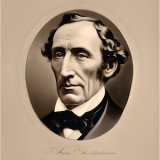The Metal Pig Page #2
"The Metal Pig" is a captivating tale by Hans Christian Andersen about a young boy named Gabriele, who is poor and homeless. Gabriele's life changes when he encounters a metal pig statue in front of a rich house and artistically engages with the statue. This experience makes him develop a significant passion and talent for art. He finally gets the attention of a noble family that allows him to live with them and nurture his artistry. The book highlights how one's life can take unpredictable turns and the impact of art on individuals.
church every statue on the richly carved sarcophagi seemed endowed with life. Here stood Michael Angelo; there Dante, with the laurel wreath round his brow; Alfieri and Machiavelli; for here side by side rest the great men--the pride of Italy. The church itself is very beautiful, even more beautiful than the marble cathedral at Florence, though not so large. It seemed as if the carved vestments stirred, and as if the marble figures they covered raised their heads higher, to gaze upon the brightly colored glowing altar where the white-robed boys swung the golden censers, amid music and song, while the strong fragrance of incense filled the church, and streamed forth into the square. The boy stretched forth his hands towards the light, and at the same moment the Metal Pig started again so rapidly that he was obliged to cling tightly to him. The wind whistled in his ears, he heard the church door creak on its hinges as it closed, and it seemed to him as if he had lost his senses--then a cold shudder passed over him, and he awoke. It was morning; the Metal Pig stood in its old place on the Porta Rosa, and the boy found he had slipped nearly off its back. Fear and trembling came upon him as he thought of his mother; she had sent him out the day before to get some money, he had not done so, and now he was hungry and thirsty. Once more he clasped the neck of his metal horse, kissed its nose, and nodded farewell to it. Then he wandered away into one of the narrowest streets, where there was scarcely room for a loaded donkey to pass. A great iron-bound door stood ajar; he passed through, and climbed up a brick staircase, with dirty walls and a rope for a balustrade, till he came to an open gallery hung with rags. From here a flight of steps led down to a court, where from a well water was drawn up by iron rollers to the different stories of the house, and where the water-buckets hung side by side. Sometimes the roller and the bucket danced in the air, splashing the water all over the court. Another broken-down staircase led from the gallery, and two Russian sailors running down it almost upset the poor boy. They were coming from their nightly carousal. A woman not very young, with an unpleasant face and a quantity of black hair, followed them. "What have you brought home?" she asked, when she saw the boy. "Don't be angry," he pleaded; "I received nothing, I have nothing at all;" and he seized his mother's dress and would have kissed it. Then they went into a little room. I need not describe it, but only say that there stood in it an earthen pot with handles, made for holding fire, which in Italy is called a marito. This pot she took in her lap, warmed her fingers, and pushed the boy with her elbow. "Certainly you must have some money," she said. The boy began to cry, and then she struck him with her foot till he cried out louder. "Will you be quiet? or I'll break your screaming head;" and she swung about the fire-pot which she held in her hand, while the boy crouched to the earth and screamed. Then a neighbor came in, and she had also a marito under her arm. "Felicita," she said, "what are you doing to the child?" "The child is mine," she answered; "I can murder him if I like, and you too, Giannina." And then she swung about the fire-pot. The other woman lifted up hers to defend herself, and the two pots clashed together so violently that they were dashed to pieces, and fire and ashes flew about the room. The boy rushed out at the sight, sped across the courtyard, and fled from the house. The poor child ran till he was quite out of breath; at last he stopped at the church, the doors of which were opened to him the night before, and went in. Here everything was bright, and the boy knelt down by the first tomb on his right, the grave of Michael Angelo, and sobbed as if his heart would break. People came and went, mass was performed, but no one noticed the boy, excepting an elderly citizen, who stood still and looked at him for a moment, and then went away like the rest. Hunger and thirst overpowered the child, and he became quite faint and ill. At last he crept into a corner behind the marble monuments, and went to sleep. Towards evening he was awakened by a pull at his sleeve; he started up, and the same old citizen stood before him. "Are you ill? where do you live? have you been here all day?" were some of the questions asked by the old man. After hearing his answers, the old man took him home to a small house close by, in a back street. They entered a glovemaker's shop, where a woman sat sewing busily. A little white poodle, so closely shaven that his pink skin could plainly be seen, frisked about the room, and gambolled upon the boy. "Innocent souls are soon intimate," said the woman, as she caressed both the boy and the dog. These good people gave the child food and drink, and said he should stay with them all night, and that the next day the old man, who was called Giuseppe, would go and speak to his mother. A little homely bed was prepared for him, but to him who had so often slept on the hard stones it was a royal couch, and he slept sweetly and dreamed of the splendid pictures and of the Metal Pig. Giuseppe went out the next morning, and the poor child was not glad to see him go, for he knew that the old man was gone to his mother, and that, perhaps, he would have to go back. He wept at the thought, and then he played with the little, lively dog, and kissed it, while the old woman looked kindly at him to encourage him. And what news did Giuseppe bring back? At first the boy could not hear, for he talked a great deal to his wife, and she nodded and stroked the boy's cheek. Then she said, "He is a good lad, he shall stay with us, he may become a clever glovemaker, like you. Look what delicate fingers he has got; Madonna intended him for a glovemaker." So the boy stayed with them, and the woman herself taught him to sew; and he ate well, and slept well, and became very merry. But at last he began to tease Bellissima, as the little dog was called. This made the woman angry, and she scolded him and threatened him, which made him very unhappy, and he went and sat in his own room full of sad thoughts. This chamber looked upon the street, in which hung skins to dry, and there were thick iron bars across his window. That night he lay awake, thinking of the Metal Pig; indeed, it was always in his thoughts. Suddenly he fancied he heard feet outside going pit-a-pat. He sprung out of bed and went to the window. Could it be the Metal Pig? But there was nothing to be seen; whatever he had heard had passed already. Next morning, their neighbor, the artist, passed by, carrying a paint-box and a large roll of canvas. "Help the gentleman to carry his box of colors," said the woman to the boy; and he obeyed instantly, took the box, and followed the painter. They walked on till they reached the picture gallery, and mounted the same staircase up which he had ridden that night on the
Translation
Translate and read this book in other languages:
Select another language:
- - Select -
- 简体中文 (Chinese - Simplified)
- 繁體中文 (Chinese - Traditional)
- Español (Spanish)
- Esperanto (Esperanto)
- 日本語 (Japanese)
- Português (Portuguese)
- Deutsch (German)
- العربية (Arabic)
- Français (French)
- Русский (Russian)
- ಕನ್ನಡ (Kannada)
- 한국어 (Korean)
- עברית (Hebrew)
- Gaeilge (Irish)
- Українська (Ukrainian)
- اردو (Urdu)
- Magyar (Hungarian)
- मानक हिन्दी (Hindi)
- Indonesia (Indonesian)
- Italiano (Italian)
- தமிழ் (Tamil)
- Türkçe (Turkish)
- తెలుగు (Telugu)
- ภาษาไทย (Thai)
- Tiếng Việt (Vietnamese)
- Čeština (Czech)
- Polski (Polish)
- Bahasa Indonesia (Indonesian)
- Românește (Romanian)
- Nederlands (Dutch)
- Ελληνικά (Greek)
- Latinum (Latin)
- Svenska (Swedish)
- Dansk (Danish)
- Suomi (Finnish)
- فارسی (Persian)
- ייִדיש (Yiddish)
- հայերեն (Armenian)
- Norsk (Norwegian)
- English (English)
Citation
Use the citation below to add this book to your bibliography:
Style:MLAChicagoAPA
"The Metal Pig Books." Literature.com. STANDS4 LLC, 2025. Web. 22 Jan. 2025. <https://www.literature.com/book/the_metal_pig_2195>.




Discuss this The Metal Pig book with the community:
Report Comment
We're doing our best to make sure our content is useful, accurate and safe.
If by any chance you spot an inappropriate comment while navigating through our website please use this form to let us know, and we'll take care of it shortly.
Attachment
You need to be logged in to favorite.
Log In